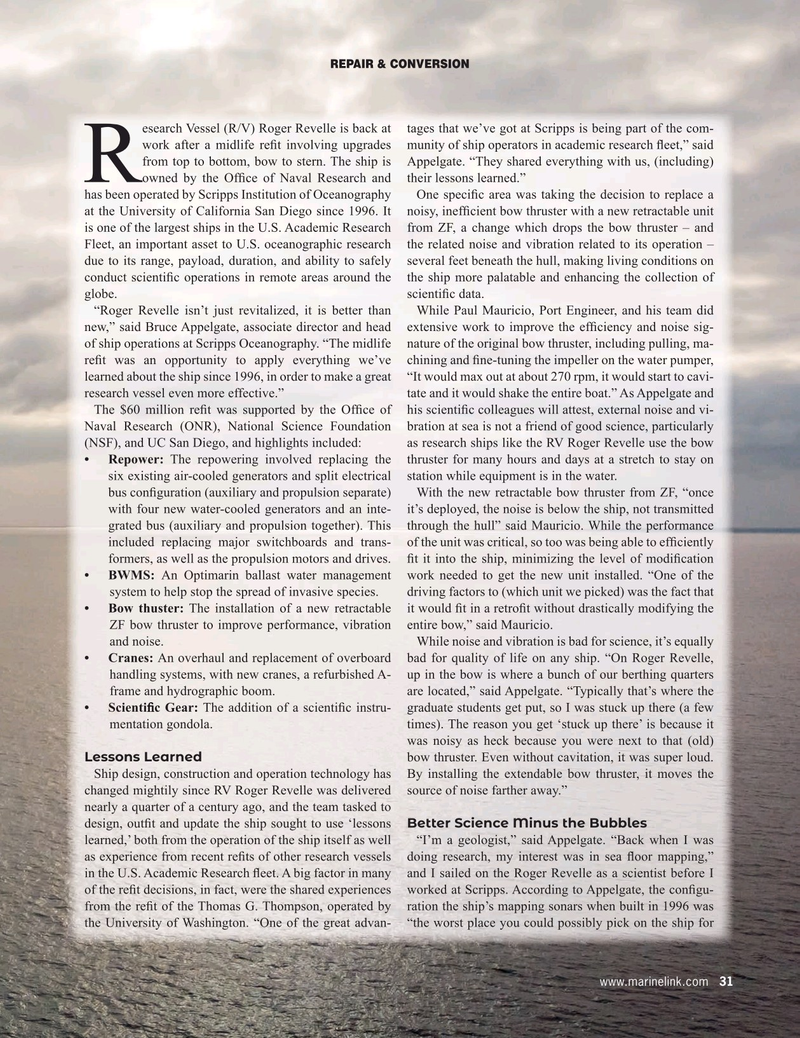
Page 31: of Maritime Reporter Magazine (January 2021)
The Ship Repair & Conversion Edition
Read this page in Pdf, Flash or Html5 edition of January 2021 Maritime Reporter Magazine
REPAIR & CONVERSION esearch Vessel (R/V) Roger Revelle is back at tages that we’ve got at Scripps is being part of the com- work after a midlife re? t involving upgrades munity of ship operators in academic research ? eet,” said from top to bottom, bow to stern. The ship is Appelgate. “They shared everything with us, (including)
R owned by the Of? ce of Naval Research and their lessons learned.” has been operated by Scripps Institution of Oceanography One speci? c area was taking the decision to replace a at the University of California San Diego since 1996. It noisy, inef? cient bow thruster with a new retractable unit is one of the largest ships in the U.S. Academic Research from ZF, a change which drops the bow thruster – and
Fleet, an important asset to U.S. oceanographic research the related noise and vibration related to its operation – due to its range, payload, duration, and ability to safely several feet beneath the hull, making living conditions on conduct scienti? c operations in remote areas around the the ship more palatable and enhancing the collection of globe. scienti? c data.
“Roger Revelle isn’t just revitalized, it is better than While Paul Mauricio, Port Engineer, and his team did new,” said Bruce Appelgate, associate director and head extensive work to improve the ef? ciency and noise sig- of ship operations at Scripps Oceanography. “The midlife nature of the original bow thruster, including pulling, ma- re? t was an opportunity to apply everything we’ve chining and ? ne-tuning the impeller on the water pumper, learned about the ship since 1996, in order to make a great “It would max out at about 270 rpm, it would start to cavi- research vessel even more effective.” tate and it would shake the entire boat.” As Appelgate and
The $60 million re? t was supported by the Of? ce of his scienti? c colleagues will attest, external noise and vi-
Naval Research (ONR), National Science Foundation bration at sea is not a friend of good science, particularly (NSF), and UC San Diego, and highlights included: as research ships like the RV Roger Revelle use the bow • Repower: The repowering involved replacing the thruster for many hours and days at a stretch to stay on six existing air-cooled generators and split electrical station while equipment is in the water.
bus con? guration (auxiliary and propulsion separate) With the new retractable bow thruster from ZF, “once with four new water-cooled generators and an inte- it’s deployed, the noise is below the ship, not transmitted grated bus (auxiliary and propulsion together). This through the hull” said Mauricio. While the performance included replacing major switchboards and trans- of the unit was critical, so too was being able to ef? ciently formers, as well as the propulsion motors and drives. ? t it into the ship, minimizing the level of modi? cation • BWMS: An Optimarin ballast water management work needed to get the new unit installed. “One of the system to help stop the spread of invasive species. driving factors to (which unit we picked) was the fact that • Bow thuster: The installation of a new retractable it would ? t in a retro? t without drastically modifying the
ZF bow thruster to improve performance, vibration entire bow,” said Mauricio.
and noise. While noise and vibration is bad for science, it’s equally • Cranes: An overhaul and replacement of overboard bad for quality of life on any ship. “On Roger Revelle, handling systems, with new cranes, a refurbished A- up in the bow is where a bunch of our berthing quarters frame and hydrographic boom. are located,” said Appelgate. “Typically that’s where the • Scienti? c Gear: The addition of a scienti? c instru- graduate students get put, so I was stuck up there (a few mentation gondola. times). The reason you get ‘stuck up there’ is because it was noisy as heck because you were next to that (old)
Lessons Learned bow thruster. Even without cavitation, it was super loud.
Ship design, construction and operation technology has By installing the extendable bow thruster, it moves the changed mightily since RV Roger Revelle was delivered source of noise farther away.” nearly a quarter of a century ago, and the team tasked to design, out? t and update the ship sought to use ‘lessons Better Science Minus the Bubbles learned,’ both from the operation of the ship itself as well “I’m a geologist,” said Appelgate. “Back when I was as experience from recent re? ts of other research vessels doing research, my interest was in sea ? oor mapping,” in the U.S. Academic Research ? eet. A big factor in many and I sailed on the Roger Revelle as a scientist before I of the re? t decisions, in fact, were the shared experiences worked at Scripps. According to Appelgate, the con? gu- from the re? t of the Thomas G. Thompson, operated by ration the ship’s mapping sonars when built in 1996 was the University of Washington. “One of the great advan- “the worst place you could possibly pick on the ship for www.marinelink.com 31
MR #1 (18-33).indd 31 1/7/2021 4:55:42 PM

 30
30

 32
32
